aka Generative Testing¶
aka "I'm too lazy to come up with test cases"¶
What is property-based/generative testing?¶
- property-based: check that statements or invariants are true for an example
- generative: automatically generate examples
Two separate ideas, but usually practiced together.
Instead of checking for equality...¶
def test_sort_on_example():
assert sorted([3, 5, 18, 2, -4]) == [-4, 2, 3, 5, 18]
Describe a property that should be true.¶
from hypothesis import given
from hypothesis.strategies import lists, integers
@given(lists(integers()))
def test_sort_produces_correct_order(a_list):
sorted_lst = sorted(a_list)
for ix in range(len(sorted_lst) - 1):
assert sorted_lst[ix] <= sorted_lst[ix + 1]
How to do property-based/generative testing¶
- Generate an "arbitrary example" of the input for the function under test.
lists(integers())is a generic example of a list of integers.- Testing libraries have built-ins for primitive types, but we'll see later how to make more complicated structures.
- Come up with "properties" of the function under test.
- Not like 'obj.attribute'
- More like "The output of
sortedis a list of the same length as its input"
- Use your "arbitary example" generator to run through tons of examples. Try and find a case where the property fails.
- 'shrink'-ability of failure cases.
- [-389294971153641476861717385245149368395L, -389294971153641476861717385244970907453L, 988, -88, 1665, 1649, -389294971153641476861717385245047265893L, ..., -938, -389294971153641476861717385244722191400L, -389294971153641476861717385245315066655L, 751, -389294971153641476861717385244787482770L]
- becomes [0, -1]
- specifically testing edge-cases
- eg,
0,+/-Inf,[],''
- eg,
- database of failed cases (reproducibility)
- not yet in testcheck.js
Convert from 15 to 18:¶
- Split the fifteen characters into three groups of five.
- For each group of five:
- Make a length-5 bitstring (eg
01001) encoding whether the letter at each position is capitalized - Use a lookup table to map that bitstring to a letter. Tack the letter onto the end.
- After doing this for each group of five, the last three positions of the id encode the capitalization of the rest of the string.
Convert from 18 to 15: do the reverse¶
def sfid_18_to_15(sf_id):
sf_id = list(sf_id)
for i in range(3):
bitmask = 'abcdefghijklmnopqrstuvwxyz012345'.index(sf_id[15 + i])
for j in range(5):
if bitmask & (1 << j):
sf_id[i * 5 + j] = sf_id[i * 5 + j].upper()
else:
sf_id[i * 5 + j] = sf_id[i * 5 + j].lower()
return ''.join(sf_id[:15])
def sfid_15_to_18(sf_id):
suffix = []
for i in range(3):
flags = 0
for j in range(5):
c = sf_id[i * 5 + j]
if 'A' <= c <= 'Z':
flags += 1 << j
suffix.append('abcdefghijklmnopqrstuvwxyz012345'[flags])
return sf_id + ''.join(suffix)
Can you spot the error?
What can we test?¶
- Passing through both conversions, an 18-char id comes out the same
@given(sampled_from(SF_18_CHAR_IDS))
def test_18_to_15_to_18_roundtrip(sf_18_char):
assert sf_18_char == sfid_15_to_18(sfid_18_to_15(sf_18_char))
test_18_to_15_to_18_roundtrip()
- Passing through both conversions, a 15-char id comes out the same
@given(sampled_from(SF_15_CHAR_IDS))
def test_15_to_18_to_15_roundtrip(sf_15_char):
assert sf_15_char == sfid_18_to_15(sfid_15_to_18(sf_15_char))
test_15_to_18_to_15_roundtrip()
no problems so far, maybe we're good?
- An 18-char id should be case-insensitive
@given(sampled_from(SF_18_CHAR_IDS))
def test_18_char_is_case_insensitive(sf_18_char):
assert all_same(
sfid_18_to_15(sf_18_char),
sfid_18_to_15(sf_18_char.lower()),
sfid_18_to_15(sf_18_char.upper()),
sfid_18_to_15(sf_18_char.swapcase()))
test_18_char_is_case_insensitive()
Falsifying example: test_18_char_is_case_insensitive(sf_18_char='00600000002nxMDaay')
--------------------------------------------------------------------------- ValueError Traceback (most recent call last) <ipython-input-11-b926b06fa861> in <module>() ----> 1 test_18_char_is_case_insensitive() <ipython-input-10-7fb62f71f9bd> in test_18_char_is_case_insensitive() 1 @given(sampled_from(SF_18_CHAR_IDS)) ----> 2 def test_18_char_is_case_insensitive(sf_18_char): 3 assert all_same( 4 sfid_18_to_15(sf_18_char), 5 sfid_18_to_15(sf_18_char.lower()), ~/.virtualenvs/property-based-testing-talk/lib/python3.5/site-packages/hypothesis/core.py in wrapped_test(*arguments, **kwargs) 719 state = StateForActualGivenExecution( 720 test_runner, search_strategy, test, settings, random) --> 721 state.run() 722 723 for attr in dir(test): ~/.virtualenvs/property-based-testing-talk/lib/python3.5/site-packages/hypothesis/core.py in run(self) 612 reify_and_execute( 613 self.search_strategy, self.test, --> 614 print_example=True, is_final=True 615 )) 616 except (UnsatisfiedAssumption, StopTest): ~/.virtualenvs/property-based-testing-talk/lib/python3.5/site-packages/hypothesis/executors.py in default_new_style_executor(data, function) 56 57 def default_new_style_executor(data, function): ---> 58 return function(data) 59 60 ~/.virtualenvs/property-based-testing-talk/lib/python3.5/site-packages/hypothesis/core.py in run(data) 113 lambda: 'Trying example: %s(%s)' % ( 114 test.__name__, arg_string(test, args, kwargs))) --> 115 return test(*args, **kwargs) 116 return run 117 <ipython-input-10-7fb62f71f9bd> in test_18_char_is_case_insensitive(sf_18_char) 4 sfid_18_to_15(sf_18_char), 5 sfid_18_to_15(sf_18_char.lower()), ----> 6 sfid_18_to_15(sf_18_char.upper()), 7 sfid_18_to_15(sf_18_char.swapcase())) <ipython-input-5-7ba554829509> in sfid_18_to_15(sf_id) 2 sf_id = list(sf_id) 3 for i in range(3): ----> 4 bitmask = 'abcdefghijklmnopqrstuvwxyz012345'.index(sf_id[15 + i]) 5 for j in range(5): 6 if bitmask & (1 << j): ValueError: substring not found
# Avoiding tracebacks in the slides using this helper function,
print_failure_case(test_18_char_is_case_insensitive)
Falsifying example: test_18_char_is_case_insensitive(sf_18_char='00600000002nxMDaay')
def sfid_18_to_15(sf_id):
sf_id = list(sf_id)
for i in range(3):
bitmask = 'abcdefghijklmnopqrstuvwxyz012345'.index(sf_id[15 + i].lower())
# added .lower() ^
for j in range(5):
if bitmask & (1 << j):
sf_id[i * 5 + j] = sf_id[i * 5 + j].upper()
else:
sf_id[i * 5 + j] = sf_id[i * 5 + j].lower()
return ''.join(sf_id[:15])
test_18_char_is_case_insensitive() # now it passes!
How to come up with properties?¶
Roundtrip examples -- normalize/denormalize¶
In NREL/openstudio-geometry-editor, we store a geometry object like:
{
id: 1,
vertices: [
{id: 'a', x: 0, y: 16}, {id: 'b', x: 4, y: 16},
{id: 'c', x: 0, y: 10}, {id: 'd', x: 4, y: 10},
],
edges: [
{ id: 'ab', v1: 'a', v2: 'b' }, { id: 'bd', v1: 'b', v2: 'd' },
{ id: 'cd', v1: 'c', v2: 'd' }, { id: 'ac', v1: 'a', v2: 'c' },
],
faces: [
{id: 'top', edgeRefs: [
{edge_id: 'ab', reverse: false}, {edge_id: 'bd', reverse: false},
{edge_id: 'cd', reverse: true}, {edge_id: 'ac', reverse: true},
]},
],
}
How to come up with properties example: normalize/denormalize¶
Often, a denormalized structure is easier to work with:
{
id: 1,
vertices: [
{id: 'a', x: 0, y: 16}, {id: 'b', x: 4, y: 16},
{id: 'c', x: 0, y: 10}, {id: 'd', x: 4, y: 10},
],
edges: [
{ id: 'ab', v1: {id: 'a', x: 0, y: 16}, v2: {id: 'b', x: 4, y: 16} },
{ id: 'bd', v1: {id: 'b', x: 4, y: 16}, v2: {id: 'd', x: 4, y: 10} },
{ id: 'cd', v1: {id: 'c', x: 0, y: 10}, v2: {id: 'd', x: 4, y: 10} },
{ id: 'ac', v1: {id: 'a', x: 0, y: 16}, v2: {id: 'c', x: 0, y: 10} },
],
faces: [
{id: 'top', edgeRefs: [
{ edge: { id: 'ab', v1: {id: 'a', x: 0, y: 16}, v2: {id: 'b', x: 4, y: 16} },
reverse: false },
{ edge: { id: 'bd', v1: {id: 'b', x: 4, y: 16}, v2: {id: 'd', x: 4, y: 10} },
reverse: false },
{ edge: { id: 'cd', v1: {id: 'c', x: 0, y: 10}, v2: {id: 'd', x: 4, y: 10} },
reverse: true },
{ edge: { id: 'ac', v1: {id: 'a', x: 0, y: 16}, v2: {id: 'c', x: 0, y: 10} },
reverse: true },
]},
],
}
How to come up with properties example: normalize/denormalize¶
import { gen, check, property } from 'testcheck';
describe('denormalize', () => {
it('is undone by normalize', () => {
const result = check(property(
gen.oneOf(_.values(geometryExamples)),
(geom) => {
assertEqual(
geom,
normalize(denormalize(geom)),
);
},
));
assert(resp.result, 'Property failed to verify!');
});
});
Aside: using testcheck.js¶
check(property(...)) won't throw an error on it's own. I wrote this helper function:
function assertProperty(...args) {
// if last parameter is not a function, assume it's config for call to check()
const checkConfig = _.isFunction(args[args.length - 1]) ? {} : args.pop();
let resp = check(property(...args), checkConfig);
if (resp.result instanceof Error) {
resp = resp.shrunk || resp;
console.error(`${resp.result}`);
console.error(
`Property failed to verify on input: ${JSON.stringify(resp.smallest || resp.fail)}`);
throw resp.result;
}
assert(resp.result, `Property failed to verify! ${JSON.stringify(resp)}`);
}
# sorting
@given(lists(integers()))
def test_sort_is_fixed_point(a_list):
assert sorted(a_list) == sorted(sorted(a_list))
# set operations
@given(sets(integers()), sets(integers()))
def test_set_ops_are_idempotent(set1, set2):
assert set1 & set2 == (set1 & set2) & set2
assert set1 | set2 == (set1 | set2) | set2
assert set1 - set2 == (set1 - set2) - set2
# first_day_of_quarter (a problem I had at my last job)
@given(datetimes())
def test_first_day_of_quarter_is_fixed_point(dt):
assert (first_day_of_quarter(dt) ==
first_day_of_quarter(first_day_of_quarter(dt)))
- maybe yours is faster
- maybe the reference is in another language?
@given(datetimes(), integers(1, 12))
def test_pg_period_string(date, base_month):
py_string = period_string(date, 'quarter', base_month)
db_string = fetchone('SELECT quarter_str(%s, %s)', (base_month, date))[0]
assert py_string == db_string
- binary search is famously hard to get right, so maybe compare with a linear search?
@given(lists(integers()), lists(integers()))
def test_list_length_is_preserved_on_addition(a, b):
assert len(a + b) == len(a) + len(b)
assertEqual(prime_factors(4), [2, 2])
Why not test that prime_factors(some_prime * some_prime) is [some_prime, some_prime]
assertProperty(
gen.oneOf(first10kPrimes),
prime => assertEqual(primeFactors(prime * prime), [prime, prime]),
);
An Example: merge sort¶
def merge_sort(lst):
if len(lst) <= 1:
return lst
middle = len(lst) // 2
left = merge_sort(lst[:middle])
right = merge_sort(lst[middle:])
return merge(left, right)
def merge(left, right):
if not left or not right:
# base case: one of the arrays is empty
return left or right
result = []
ix, jx = 0, 0
while ix < len(left) and jx < len(right):
if left[ix] <= right[jx]:
result.append(left[ix])
ix += 1
else:
result.append(right[jx])
jx += 1
return result
@given(lists(integers()))
def test_sort_produces_correct_order(a_list):
sorted_lst = merge_sort(a_list)
for ix in range(len(sorted_lst) - 1):
assert sorted_lst[ix] <= sorted_lst[ix + 1]
@given(lists(integers()))
def test_sort_is_fixed_point(a_list):
sorted_lst = merge_sort(a_list)
assert sorted_lst == merge_sort(sorted_lst)
test_sort_produces_correct_order()
test_sort_is_fixed_point()
@given(lists(integers()))
def test_sort_maintains_length(a_list):
sorted_lst = merge_sort(a_list)
assert len(sorted_lst) == len(a_list)
@given(lists(integers()))
def test_sorted_list_has_same_elements(a_list):
sorted_lst = merge_sort(a_list)
# A Counter is a map from element of the list to the number of times
# it appears.
assert Counter(sorted_lst) == Counter(a_list)
@given(lists(integers()))
def test_sort_against_reference(a_list):
assert merge_sort(a_list) == sorted(a_list)
an example: merge sort¶
Unfortunately, these last three all fail.
print_failure_case(test_sort_maintains_length)
print_failure_case(test_sorted_list_has_same_elements)
print_failure_case(test_sort_against_reference)
Falsifying example: test_sort_maintains_length(a_list=[0, 0]) Falsifying example: test_sorted_list_has_same_elements(a_list=[0, 0]) Falsifying example: test_sort_against_reference(a_list=[0, 0])
merge_sort([0, 0])
[0]
def merge(left, right):
if not left or not right:
# base case: one of the arrays is empty
return left or right
result = []
ix, jx = 0, 0
while ix < len(left) and jx < len(right):
if left[ix] <= right[jx]:
result.append(left[ix])
ix += 1
else:
result.append(right[jx])
jx += 1
return result
We're never copying remaining elements from left[ix:] or right[jx:].
an example: merge sort¶
def merge(left, right):
if not left or not right:
# base case: one of the arrays is empty
return left or right
result = []
ix, jx = 0, 0
while ix < len(left) and jx < len(right):
if left[ix] <= right[jx]:
result.append(left[ix])
ix += 1
else:
result.append(right[jx])
jx += 1
# Adding this:
result.extend(left[ix:])
result.extend(right[jx:])
return result
an example: merge sort¶
Now our tests pass...
test_sort_produces_correct_order()
test_sort_is_fixed_point()
test_sort_maintains_length()
test_sorted_list_has_same_elements()
test_sort_against_reference()
How to write a generator/strategy¶
Besides the built in generators provided by hypothesis and testcheck.js, it's useful to create your own custom generators to make examples of your domain objects.
- hypothesis provides
builds, that takes a function and some strategies in*args, **kwargs:
# example from bgschiller/hangman-api
def new_puzzle(word=None):
word = word or random.choice(WORDS)
return {
'word_so_far': list('_' * len(word)),
'actual_word': word.upper(),
'guesses': [],
}
puzzle_strategy = builds(new_puzzle, word=sampled_from(WORDS))
puzzle_strategy.example()
#{'actual_word': 'TRACE',
# 'guesses': [],
# 'word_so_far': ['_', '_', '_', '_', '_']}
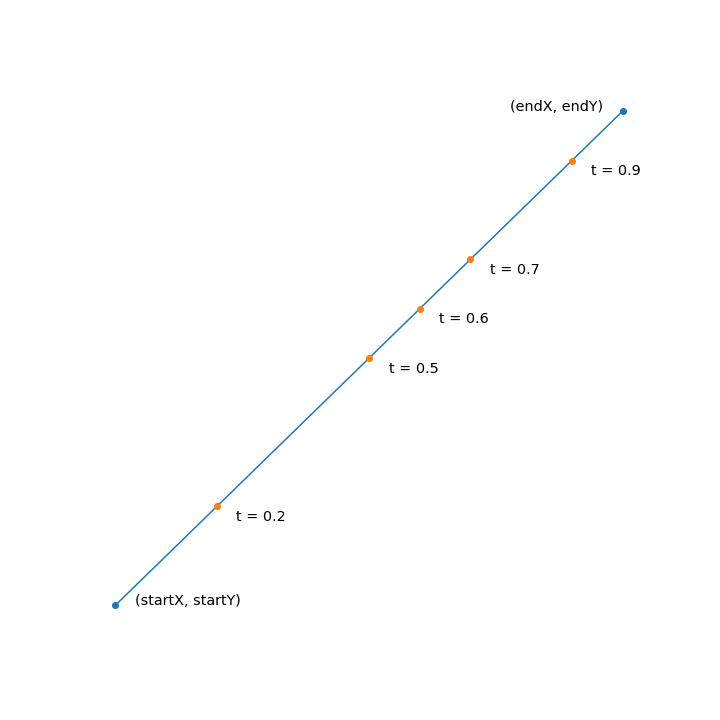
const genVertices = gen.object({
startX: gen.numberWithin(-10000, 10000),
startY: gen.numberWithin(-10000, 10000),
endX: gen.numberWithin(-10000, 10000),
endY: gen.numberWithin(-10000, 10000),
pointsAlong: gen.array(gen.numberWithin(0, 1), { minSize: 0, maxSize: 10 }),
})
.suchThat(({ startX, startY, endX, endY }) => startX !== endX || startY !== endY)
.then(({ startX, startY, endX, endY, pointsAlong }) => {
const toPointOnLine = t => ({
x: startX + (t * (endX - startX)),
y: startY + (t * (endY - startY)),
});
const arr = [
/* start */{ x: startX, y: startY, identity: 'start' },
/* end */{ x: endX, y: endY, identity: 'end' },
/* verts */
...pointsAlong.map(toPointOnLine),
];
if (pointsAlong.length) {
/* and a duplicate out of order for good measure */
arr.push(toPointOnLine(pointsAlong[0]));
}
return arr;
});
Generator example: polygons¶
(I use this one in NREL/openstudio-geometry-editor). A caveats:
- not completely 'expressive'
- pretty good for testing
- (better than the 3-5 examples I would have patience to write on my own)
generator example: polygons¶
A recipe for a polygon¶
- Choose a point to be the center.
- Choose a number of vertices, $n$.
- For each of $n$ equal directions (eg, when $n=3$: $0^{\circ}$, $120^{\circ}$, and $240^{\circ}$)
- Choose a distance, $d$ and plant a vertex that far away from the center in the direction chosen.



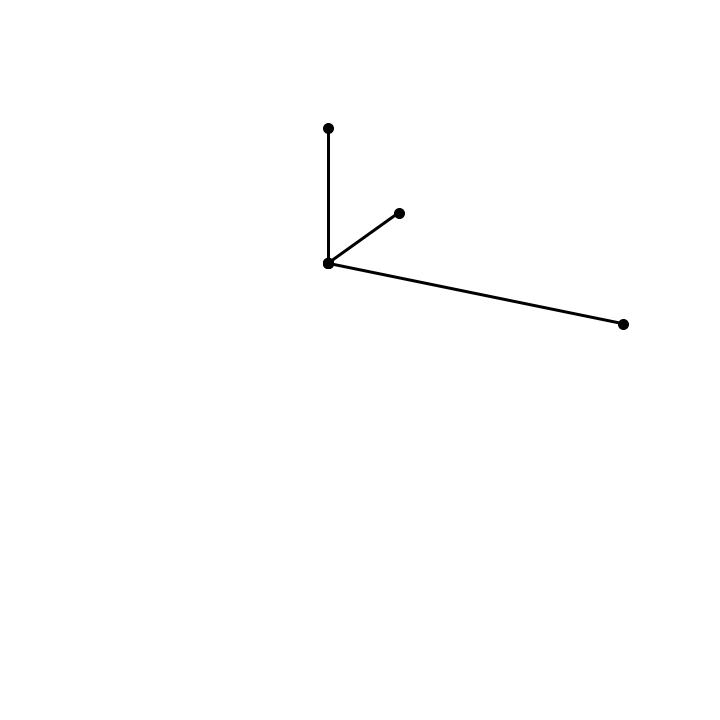
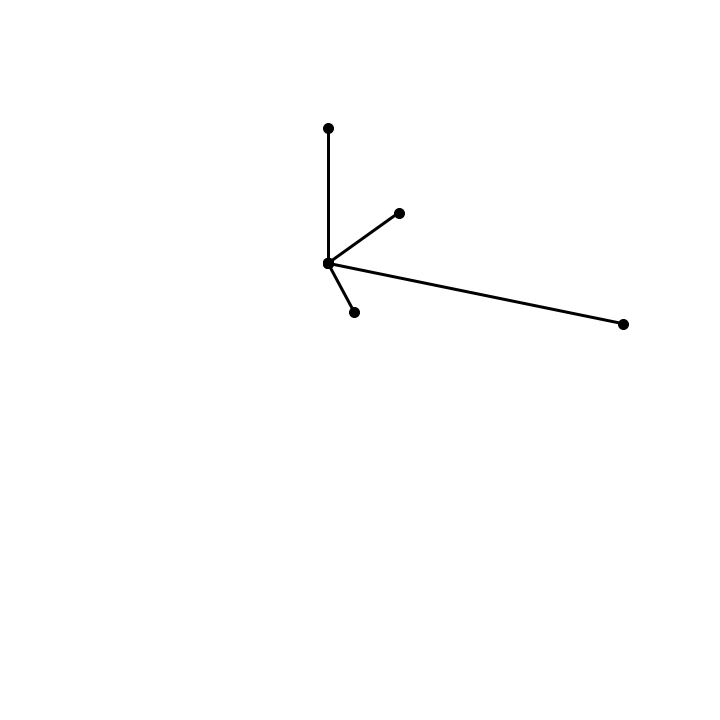
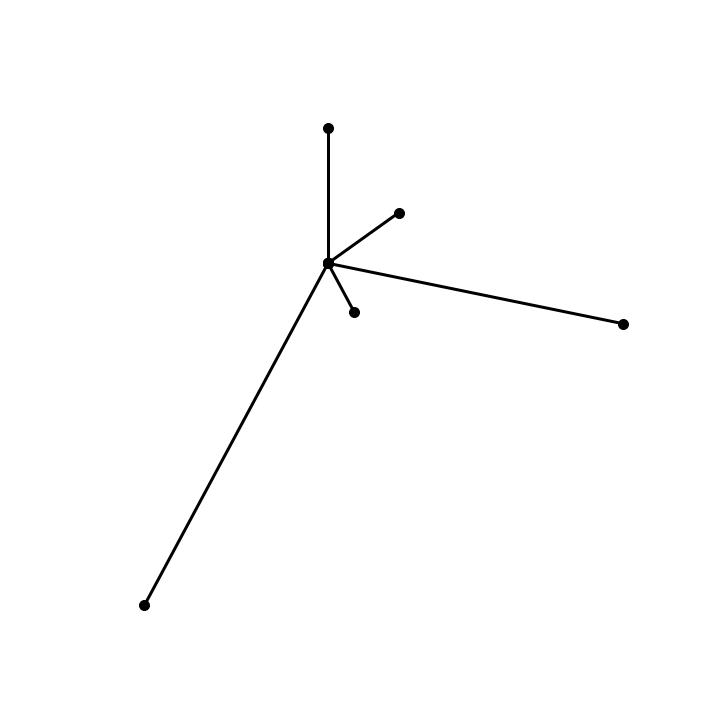
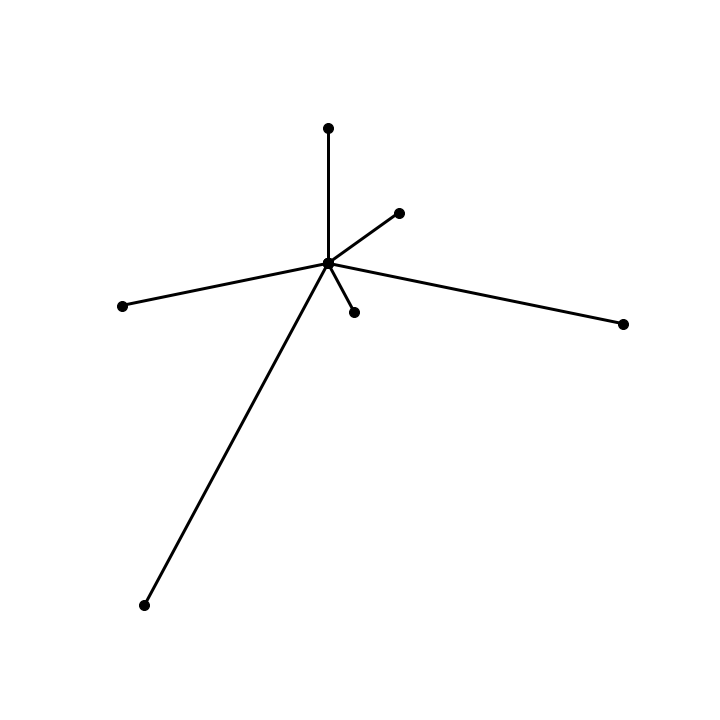
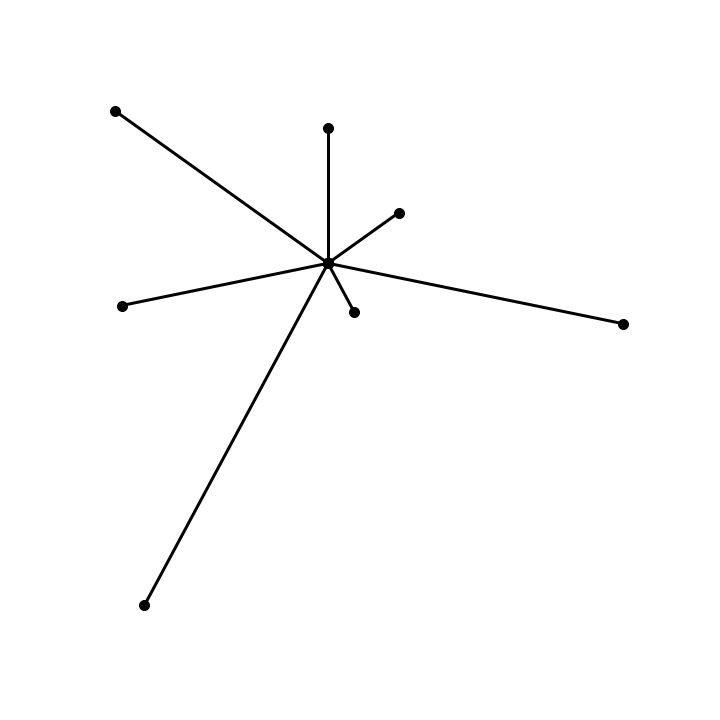

generator example: polygons
const createIrregularPolygon = ({ center, radii }) => {
const angleStep = (2 * Math.PI) / radii.length;
return radii
.map((radius, n) => ({
x: center.x + (radius * Math.sin(n * angleStep)),
y: center.y + (radius * Math.cos(n * angleStep)),
}));
};
const genIrregularPolygon = gen.object({
center: gen.object({ x: gen.int, y: gen.int }),
radii: gen.array(gen.intWithin(5, 100), { minSize: 3, maxSize: 20 }),
})
.then(createIrregularPolygon);
Throwing away examples¶
- Hypothesis has
assume - testcheck has
suchThat
# an example from the hypothesis docs
@given(floats())
def test_negation_is_self_inverse(x):
assert x == -(-x)
print_failure_case(test_negation_is_self_inverse)
Falsifying example: test_negation_is_self_inverse(x=nan)
from hypothesis import assume
from math import isnan
# an example from the hypothesis docs
@given(floats())
def test_negation_is_self_inverse(x):
assume(not isnan(x))
assert x == -(-x)
print_failure_case(test_negation_is_self_inverse)
Throwing away examples¶
testcheck has .suchThat()
const genPoint = gen.object({ x: gen.int, y: gen.int });
const genTriangle = gen.array(genPoint, { size: 3 })
.suchThat(pts => !ptsAreCollinear(...pts));
const genEvenNumber = gen.int.suchThat(n => n % 2 === 0);
const genEvenNumber = gen.int.then(n => n * 2);